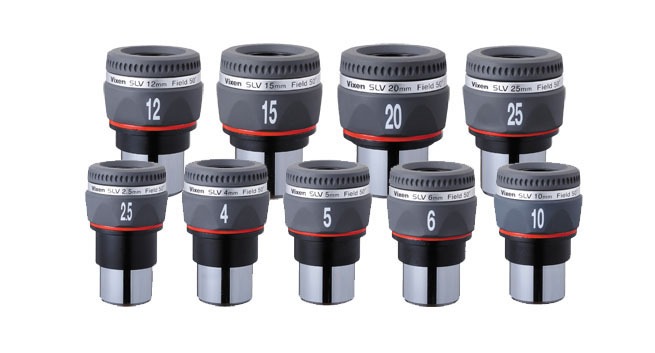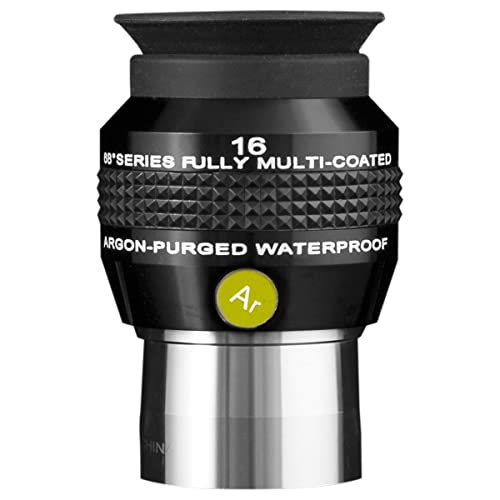
A Guide on Choosing the Best Lenses for Telescope
The lenses or eyepieces allow you to focus the light collected by the telescope, so you can observe a sharp image of the object or area where the telescope is pointing. It may seem like a small link in the chain, but it has a big effect on your telescope’s optical system, and finding the right eyepieces will greatly increase its potential.
With so many options to choose from, getting the right set of eyepieces for you and your telescope can seem a bit tricky. This guide offers some insights and explanations about the different types of Lenses for Telescope, specifications and how it all connects to optimize your astronomy and astrophotography sessions!
Focal Length and Magnification
Focal length is an important specification that must be considered when determining the magnification, also known as power, of the eyepiece and telescope with which it is used. The following formula will help you determine the magnification based on the specifications of your eyepiece and telescope:
Magnification = Focal length of the telescope (mm) / Focal length of the eyepiece (mm)
For example:
The 20 mm eyepiece of the 2000 mm telescope (2000/20) gives you 100 power (100x), which makes objects appear 100 times closer to you through the telescope than they look to your naked eye.
Field of view: Apparent and true
The apparent field of view of the eyepiece (AFOV) is expressed in degrees (°). This is how much of the sky can be seen from end to end only through the eyepiece. AFOV range from narrow (25 ° – 30 °) to extremely wide angle (80 ° or more).
The true field of view of the eyepiece is the angle of the sky that is visible through the eyepiece when attached to the telescope. The true field can be calculated using the following formula:
True field = visible field / magnification
Suppose, for example, that you have an 8-inch Schmidt-Cassegrain telescope with a focal length of 2000 mm and a 20 mm eyepiece with a field of view of 50 °. The magnification will be 2000 mm / 20 mm = 100x. The true field would be 50 \ 100 or 0.5 ° – approximately the same visible diameter as the full moon.

Long Eye Relief
Eye Relief refers to the distance between your eye and the eyepiece lens when the image is in focus. The relief of the eyes is traditionally proportional to the focal length: The shorter the focal length, the shorter the relief of the eyes. However, some of the more modern eyepiece designs provide long-eye relief, regardless of the focal length, which is especially useful for those who wear glasses. If you want to keep your glasses while using a telescope, the relief of the eyepiece is an important feature that must be taken into account (we recommend looking at the eyepieces for long-eyed relief).
How many Lenses for Telescope do I really need?
Although there is no specific number of Lenses for Telescopes to own, with a few different telescope eyepieces you have a better chance of reaching the optimal power for the particular object you are observing, given the sky conditions at the time. You will usually want to start with low power (i.e., a long focal length of the eyepiece, for example 25 mm or 30 mm) to get the object in the field of view of the telescope. Then you can try an eyepiece with a little more power (shorter focal length, maybe 18 mm or 15 mm) and see if the view looks better. If this happens, swap the eyepiece for even more power, etc., until you reach this “sweet spot” where the brightness of the image, the scale of the image, and the amount of visible detail combine to form the most pleasing view.
What about Barlow lenses?
You can also choose a long focal length eyepiece with comfortable eye relief and use image amplifiers to increase power, such as a Barlow lens. Barlow increases the effective focal length of the lens, increasing the magnification. The idea is that two eyepieces and a Barlow will give you the flexibility to zoom in on four eyepieces and will give higher magnifications with less powerful eyepieces.
The use of different eyepieces can significantly increase the flexibility and functionality of any telescope.
What is a Zoom Eyepiece?
The zoom eyepieces are a single eyepiece that you can adjust to change its focal length, which changes the magnification. You just insert the eyepiece into your telescope and simply rotate the zoom eyepiece barrel to zoom in or out of whatever you are looking at.
They tend to occupy the middle level of focal length / magnification, so you may need very high and low magnification eyepieces (short and long focal lengths, respectively), but a zoom one can handle everything between you.
Telescope Eyepiece Sets
Lenses for Telescope Sets are a great idea for anyone new to backyard astronomy. For one price, they provide a selection of eyepieces and filters to improve the versatility of your telescope setup.
The Eyepiece Set offers package of various eyepieces, conveniently providing a full array of different magnifications and powers in one place. This lets you find numerous eyepieces that are all compatible with your telescope.. The big three astronomy manufacturers, Celestron, Orion and Meade, produce their own eyepiece kits and we have selected the best one here in this article.
Basic Tips to Follow When Shopping for Eyepieces
- Consider the focal length of your telescope, or telescopes, to make sure the eyepiece will provide an appropriate magnification to suit your needs.
- If you wear eyeglasses while using a telescope, pay attention to the eye relief specification of different eyepieces, as ample eye relief can improve comfort and ease-of-use while wearing corrective lenses.
- Depending on your observing goals, consider the apparent field of view of your eyepiece choices.
- If versatility is paramount, consider a zoom eyepiece or Barlow lens to increase the number of possible magnifications to use.
Our Recommendations for Shopping Eyepieces for Telescope
Ultra Wide Field Lenses for Telescope
No products found.
No products found.
No products found.
No products found.
Wide Field Lenses for Telescope
No products found.
No products found.
No products found.
Long Eye Relief
No products found.
No products found.
No products found.
Zoom Lenses for Telescope
No products found.
Telescope Eyepiece Kits/Sets
No products found.
No products found.
No products found.
No products found.
Barlows, Correctors, & Reducers
No products found.
No products found.
No products found.
No products found.
No products found.
No products found.
No products found.
No products found.








I have really been fascinated with the universe lately. Its crazy all the stuff that goes on up there. I am in the market for a telescope to use for fun and for the kids. I know nothing really of what to buy. Would you recommend a brand. And would you get the 8-24 eye piece for someone just starting?
Yup, the Universe is something mind blowing and once you look trough Telescope you will be even more amazed! I’m definitely Celestron fan! It’s leader on the telescope market and all products are best quality. If you are looking to get a telescope, then read the article here before make a purchase.
Thanks for the comment Gareth Martin and all best!
I wanted to make a telescope and I have the body and other lenses needed and were looking for the eyepiece. How to figure out which eyepiece is the perfect one for my telescope.
This one seems like the fit however, I wanted to know if you have a post on finding out how to figure out the perfect eyepiece!
Hi Shrey 🙂
It’s interesting thing what you are doing – making a Telescope. There is article here about all the parts of the telescopes. For sure you will find it very useful. Enjoy 🙂
I’ve always been interested in buying or customizing my own telescope. I love looking up into space and going star gazing. I’ve always been fascinated with the constellations. Would you recommend buying a telescope from Celestron or do they only specialize in eyepieces? How much does magnification matter in terms of pairing up the telescope with a certain eyepiece? Also, Do you have any article that explains how telescopes work? I’m not too familiar with all that and would love to learn more. Thanks a ton!
Hi Kyle,
Happy to know you like the night sky! Definitely you should go one step further and take a telescope. You will be amazed what you can see up there. I’m recommending Celestron for two reasons: 1: They are the best on the market, and 2: I have my own Celestron NexStar SE6 for more than 5 years and its still has the best images I’ve ever seen on the telescope’s eyepiece! Speaking for eyepieces and magnification you should know that is depending of the Telescope aperture. I have good reading about this, and the structure of the Telescopes as well HERE . For any further question – I’m here to help you 🙂
Thanks for the comment! Cheers
I wanted to thank you for the information. I never in a million years would have thought to replace the eye piece increase the viewing ability of a telescope. I don’t personally own a telescope because I thought you had to buy a really expensive telescope to see things in greater detail but now this makes me realize that that is not necessarily the case.
I have to confess that I got my Telescope without knowing much about it. Few months later I figured out about the ability to replace the eyepieces. Ind that was a news! Now I have the zoomable Celestron 8-24mm and almost stop using the 25mm that I got with the Telescope.
It is not necessary to get an expensive Telescope, just choose a good one and then you are be able to change the eyepiece and see in a details whatever you like!
Thanks for the comment Daniel. Hope to see you soon staring at the night sky!
Cheers!
Hey there! I really like the set of telescope eye pieces but I’m confused. Do these go on the big telescopes that you set on the ground or are the small like a desk sized telescope? I think my daughter would really love this and it would make a nice family activity for her, my hubby and I to do some nights but I need to know what type of telescope to get first.
Hope this makes sense and I appreciate the help 🙂
Marlinda
Hi Marlinda Davis!
The small “desk” telescope are cut, but unfortunately are very useful. The good news is you just need to add little more money and you will get a proper telescope for your back yard. Read the article here about buying a first telescope – is not so many things you need to know, and get one. This will change your life, just as happened with me! If you have some question – don’t forget I’m here to help!
Thank you!